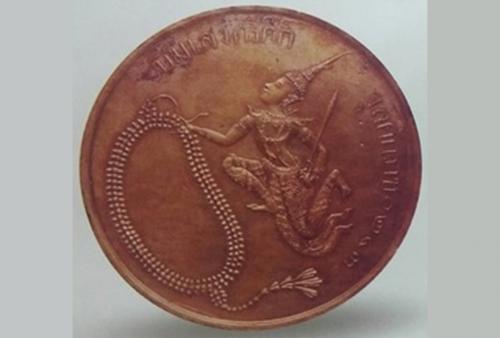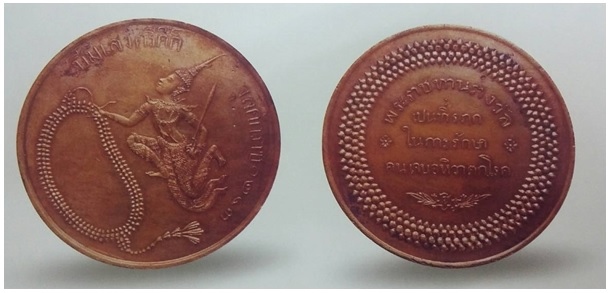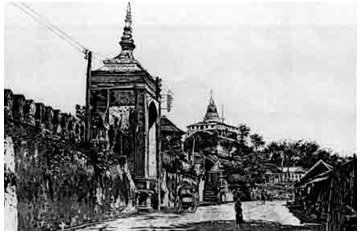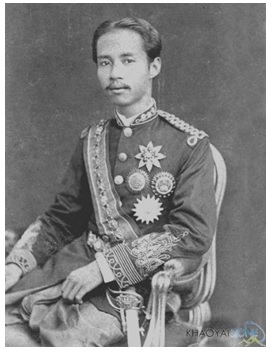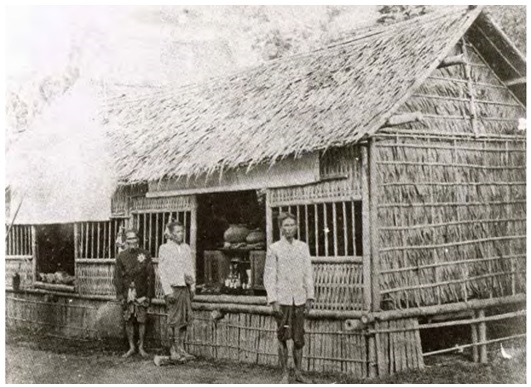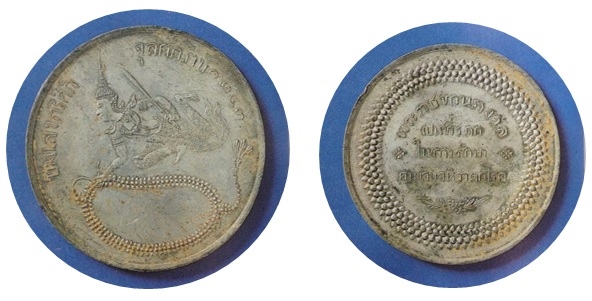Cholera is an acute, infectious disease of the digestive tract caused by bacteria and it’s assumed that the disease is an intensified form of dysentery. It is believed that the bacteria which cause cholera originated in the area of Bengal, India. The symptoms start with profuse diarrhoea of clear fluid without stomach pain. Some patients pass white, turbid fluid resembling rice water. Patients sometimes vomit, experience nausea and rapid dehydration which might result in acidosis, circulatory failure, and eventually death. However, there were no records of exact symptoms during the Cholera outbreaks in ancient Thai history.
According to historical evidence there has been a record of outbreaks since 11th Century BCE. In the Book of Jamthevi Wongse, there is a record of a cholera outbreak which occurred after the death of King Kamolrat. The record says:
"...At that time, the people of Hariphunchai Nakhon contracted cholera in greater numbers. Whichever home the disease has visited, there are deaths to all members of the house, with no one remaining alive.”
In the archive of Si Ayutthaya, written by Phra Charkrapadipongse (Jad), there is a narration of the founding of Wat Pa Kaew Temple which was built as a result of a cholera outbreak:
"... Year 725, the zodiac year of the rabbit, the royal words say, that [after] Chao Kaew and Chao Thai had passed due to Cholera, they are to be exhumed and cremated. A Chedi and a main hall were commissioned in order to found a temple, to which was given the name ‘Wat Pa Kaew’.
The aforementioned historical evidence only shows the serious effect of the disease. However, there was no mention of the cause or symptoms of the disease.
According to records, there were three outbreaks of cholera later in the early Rattanakosin period. A great cholera epidemic occurred in 1820 BCE during King Rama II’s reign, resulting in many deaths, which has been recorded in the royal archive:
"In Bangkok, from the 6th waxing moon day of the 7th lunar month until full moon, there are so many deaths, both men and women. The corpses at the graveyards and the halls of Wat Saket, Wat Bang Lamphu (Wat Sungwetch Vishayaram), Wat Bopitphimuck, Wat Prathum Khongkha as well as other temples, piled up like wooden logs. Even more [numbers of corpses] had been cremated. Those that are floating in the water are so many that monks have fled the temples; laymen have fled their homes. What a pity. No man walks the streets. There was no business at markets. People eat only dried fish and salt on their own. River water is not potable, as [the river] is full of corpses...”
At the time, King Rama II commanded that a ceremony to evict evils be held at Dusit Throne Hall. There were gun salutes around the city area. Holy relics and the Emerald Buddha were paraded around the city area. Sand and Paritta holy water were sprinkled both on the land and in water for protection. The King committed to Sila, donating of royal wealth to save the lives of four-legged and two-legged animals, pardoned convicts, and forbid the taking of lives. This ceremony was carried out after the eviction of harm in the city of Aphaisali during Buddha’s period. This was an appropriation of a Langkan idea, believing that chanting can cleanse evils away from the society.
However, this ceremony of eviction caused the cholera to strike even worse. Due to the hot weather, some of the people who took part in the parade and carried the Buddha image, as well as monks, contracted the disease and died; many more died after they returned home. Therefore, having seen that the ceremony could not stop the disease, the people generally thought that [this is] because the ceremony could not fight off the evils; the evils are much more powerful.”
After the eviction ceremony, the cholera epidemic persisted for another 15 days before it eventually subsided. At the end of this outbreak, the death toll in Bangkok and nearby cities rose up to around 30,000 in numbers.
In 1849, during the reign of King Rama III, another serious outbreak of cholera occurred. The outbreak originated in India, and then spread throughout Europe and America. The disease arrived in Siam via Pattani and Songkhla. It took three weeks to spread to Samut Prakan and the city of Bangkok by way of water, as described in the royal archive:
"...At the new moon of 7th lunar month, an illness covered the entire country. This illness came from countries across the sea, the western cities, arrived in Bangkok, and spread through the northern cities..."
At this time, King Rama III made merit and became committed to Sila. The King commanded officers to release animals every day to save their lives, which cost a great deal of money. The King also commanded the people to make merit, release caged animals, as well as to have mercy on one another. However, unlike in King Rama II's time, the eviction ceremony and Paritta chanting ceremony was not held. Regarding this, King Rama V clarified later that "since the eviction ceremony that was held in zodiac year of the dragon, where the lunisolar year ending with the number two, was not successful in stopping the disease, it was thus cancelled and not to be resumed."
The epidemic's death toll was approximately 40,000. The city of Bangkok alone lost 1,500-2,000 of its people each day. It was also the cause of death for four royal children, namely Her Royal Highness Princess Kadsinee, Her Royal Highness Princess Phuang Kaew, His Royal Highness Prince Chalerm Wongse and His Royal Highness Prince Jinda. Moreover, Chao Phraya Nakorn Badin (Toh Kalayanamit) was also among the victims of Cholera. During this outbreak, Dr. Samuel Reynolds House, who was an American doctor and missionary, had discovered a treatment for the disease. He wrote a report which was published in the United States in 1865 AD, concluding that giving the patients alcohol and camphor tincture solution to drink was frequently very effective; every patient treated with such treatment survived the epidemic. During the reign of King Rama IV, another epidemic occurred, although this time on a smaller scale than at previous times. It was mentioned in the royal archive as follows: "...In 5th lunar month, flu sickness and digestion sickness occurred in the city of Bangkok. Both had started in the town of Tak and Raheang before arriving in Bangkok. The flu sickness seemed not serious. Yet, after 14-15 days, it caused bloody diarrhoea. [The patient] remained for 40 days or only a few days more before they died. No one was found to have been cured. This outbreak was short-lived. According to an inquiry, there were two or three losses per household, before the disease subsided and disappeared...”

Dr. Samuel Reynolds House
The outbreaks of cholera during this period of time had not been contained and had claimed great numbers of victims. This was due to lack of development in medical science as well as medical personnel. People’s living conditions were unsanitary and they held the belief that the cause of disease was due to "a higher or supernatural being’s wrath”. Therefore, the treatment of the outbreaks were in forms of commitments to the Buddhist codes of conduct - Sila, releasing animals, pardoning convicts, and chanting. This had continued until missionaries became involved in the treating of patients. They introduced treatments according to western medicines, which were able to save many people's lives. Therefore, this could be said to be the point where western medicine started to replace ancient treatments.
Cholera Outbreak during the Reign of King Chulalongkorn
King Chulalongkorn
During the reign of King Chulalongkorn there was an outbreak of cholera in 1873. However, since there had already been a development in medical science, as well as a more modern treatment, there was a much better result in the success of controlling the outbreak. The total number of deaths was approximately 6,660. Prince Damrong Rachanupab recorded this event as the following:
"...In this zodiac year of the chicken, there was an outbreak of cholera in 7th lunar month. The people were panic-stricken. To cure the disease, the King ordered that there was to be medical treatments, and not to hold a religious ceremony as before. Prince Saisanitwongse, the director-general of the Bureau of Doctors, compounded two new kinds of drug according to Western science for the treatment of cholera. One is a drop medicine using a combination of Visamphaya Yai herbal medicine and alcohol; another is a camphor drop called camphor solution. It was also recommended to sprinkle camphor over clothing to prevent infections. The King asked the royal family and senior officers to take the medicine and organized dispensaries at palaces, homes, or communities in order to help treat the people across the city of Bangkok. This outbreak persisted for a month but eventually subsided.”
In 1881, there was another serious outbreak of Cholera. Carl Bock, a Norwegian naturalist, mentioned this outbreak as follows:
"...During my stay, there was a Cholera outbreak. Throughout this time the town was covered with a bad odour. At this time, the burials proceeded too slowly to handle the victims of Cholera who were being carried to Wat Saket. The numbers of the corpses sometimes ranged from 60 to 120 per day. The corpses were piled up and covered in lime. Nevertheless, this was unable to stop the odour...”
Corpses from the Cholera Outbreak
This time, King Chulalongkorn kindly ordered HRH Prince Chaturon Rasmi, the royal family, and another 48 civil servants to set up 48 medical stations in order to treat cholera patients. When the outbreak had stopped, the King then had a further thought to establish permanent hospitals.
The Devawongse Varopakarn Hospital for Cholera patients In Wat Sangveswitsayaram Subdistrict
Hospital for Cholera Patients
Progress in Medicine, the Public Health Service, and Sanitation after 1881
After the outbreak of 1881, there were several more outbreaks that followed, namely in 1891, 1900, and from 1907-1909. However, these outbreaks became less severe because His Majesty the King had adopted a policy of prevention rather than to try and cure after the disease had broken out. This policy is a very successful proactive health policy and its success was due to several factors. The first factor was that western medical science had identified the cause of the disease, resulting in the right way of planning the prevention of a cholera outbreak. Another factor is the progress of pharmacy, which attributed to the founding of the Pharmaceutical Chamber to produce and distribute medicine for the treatments of cholera and other diseases.
1. Founding of Siriraj Hospital and the Department of Health
After the cholera outbreak of 1881, Prince Damrong Rachanupab proposed the thought of founding a hospital to King Chulalongkorn, to which the King agreed. The King also saw that the proposal could be realized and appointing a committee to manage each hospital. The committee included:
1. HRH Prince Siritatchsangkas
2. HRH Prince Damrong Rachanupab
3. HRH Prince Si Saowaphang
4. HRH Prince Wattananuwongse
5. HRH Prince Saisanitwongse
6. HRH Prince Prisdang
7. Phraya Chodokratchasetthi (Sathien Chotikasathien)
8. Chao Muaen Sanpetchphakdi (Buds Phenkul)
9. Dr. Peter Gauvin, MD.
The committee asked the King for land in the south of Wang Lang palace and also bought a piece of land on the bank of the river, north of Wattana Wittayalai School to construct a pier to reach the hospital. Additionally, the King granted a 1,000 baht fund for each of the new start-ups.
On 21 May 1887, HRH Prince Siriraj Kakuta Bhundu, the fifth son of the King who was born to Queen Saovabha Phongsri, died of dysentery aged 1 year and 7 months. This incident brought the King a strong desire to establish hospitals at a quicker pace. The King donated material used in the Princes’ cremation ceremony as well as the princes’ private fund, with 700 Chung or 56,000 baht’s worth of money, to assist the hospital. King Chulalongkorn attended the opening ceremony of the hospital on 26 April 1888, and gave the name "Siriraj Hospital” to the hospital. The King also ordered that there be a Department of Health in 1889 which bears the responsibility of overseeing the business of Siriraj Hospital as well as other hospitals, for example, those near Mahachai fort and Debsirin Trawas Temple, Mental Hospital, Hospital for Prostitutes, Hospital for Patrol Guards, Sam Sen Hospital, the Royal Consort’s nursery, and also provide medical education.
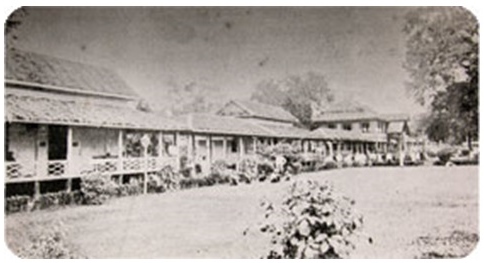
This is the first style of hospital which King Chulalongkorn donated his private funds to build, worth 200 Chung. The house was made from wood and decorated with terraces. There are three big houses and three small houses for doctors and for storing medicines including a pathway, kitchen and a bridge.
Later, the King announced the establishment of a Pharmaceutical Chamber, or Osot Sapha to manufacture, supply, sell, and distribute medicine to other main towns. Pharmacies were opened in several areas, both in Bangkok and other cities. They were called Pharmacy Halls, or Osot Sala, and were operated by the Department of Health. On this occasion, the King also granted medicine for cholera, including Cholodin along with other medicines for treatment of other diseases in order to be distributed in the outbreak areas. These medicines were stored in hospitals and patrol stations in the city as well as in pharmacies in major towns, homes of sub district headmen, and village headmen for the people’s convenience.
2. Founding of the Department of Sanitation, legislation, and announcements regarding sanitation.
The cholera outbreak in 1881 was a result of people living on the river banks disposing rubbish and waste in rivers and canals which were also the water sources for consumption. Outbreaks were frequent in the dry season because people could not find clean water to drink. King Chulalongkorn enacted the Bangkok Sanitary Act of 116 Rattanakosin Era. According to this law, a sanitation office was created with the responsible for collecting and disposing of refuse, providing public toilets, relocating filth, and overseeing constructions of homes that might be a source of outbreak. There were several other announcements and enactments regarding sanitation, for example, the announcement regarding city cleaning, and cremations at temples.
Moreover, the King solved the problem regarding drinking water among the people by appointing a committee to bring water from the upper stream of Chao Phraya River for distribution. The King commissioned the Naraphirom Canal and Preng Canal be dug and used as a reservoir for fresh water. In 1909, the King released a royal order for the Department of Health to provide running water for the people, starting in the city centre of Bangkok. The service was expanded later to other provincial towns and as a result, the running water service has become a necessity to the lives of Thai people until the present day.
